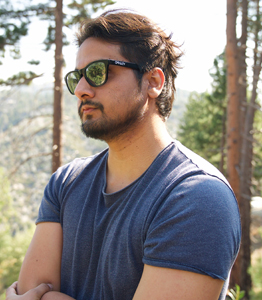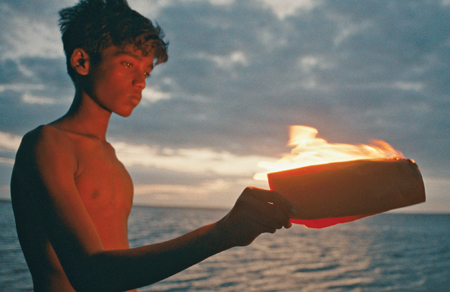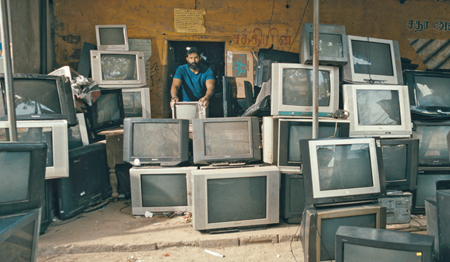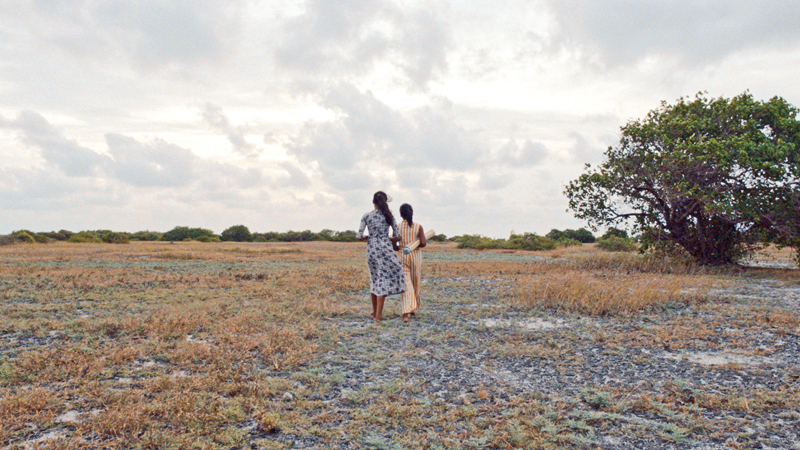 Your Touch Makes Others Invisible, the debut feature by Rajee Samarasinghe, had its world premiere at the recently concluded Rotterdam International Film Festival under the Bright Future category. Rajee’s film was the only selection from Sri Lanka at IFFR this year. As an accredited member of the press, I had the opportunity to watch the film.
Your Touch Makes Others Invisible, the debut feature by Rajee Samarasinghe, had its world premiere at the recently concluded Rotterdam International Film Festival under the Bright Future category. Rajee’s film was the only selection from Sri Lanka at IFFR this year. As an accredited member of the press, I had the opportunity to watch the film.
The film addresses the theme of disappearance and the grief experienced by the mothers of the North and the East of Sri Lanka, whose loved ones went missing as a result of the 30 years of civil war. The film’s description cites statistics indicating that 100,000 people are estimated to have disappeared, with a majority from the Tamil community. It is developed in the form of interviews with several Tamil women who share their grievances and harrowing histories as families still search for their loved ones who vanished without a trace.
This theme is not new to the international festival scene and could be considered an overrated magic trick to attract the gaze of the international festival circuit, a tactic that has been tested and proven for many years.
Festival shot
The opening imagery of Your Touch Makes Others Invisible establishes a cookie-cutter ‘festival shot’: a long tracking shot moving towards a lonely tree beside a single-story house, with dried earth, harsh sunlight, and a random little girl sitting on the ground who stands and runs away as the camera approaches. This unique historical aesthetic of long shots in arid landscapes, featuring a solitary tree and a single-story house, was introduced by Asoka Handagama in his film This Is My Moon (Me Mage Sandai) back in the 1990s, during the height of the civil war. This film marked a significant turning point in Sri Lankan cinema, providing a new human perspective on the civil war and its victims through this unique imagery.

Rajee Samarasinghe – Director Photo 1
(Photo Credit to Yanyu Dong)
This novel cinematic aesthetic was further developed and showcased in the international film festival arena by acclaimed filmmaker Vimukthi Jayasundara in his debut film ‘Forsaken Land’ (Sulanga Enu Pinisa), which won the Camera d’Or award at the Cannes Film Festival in 2005. Since then, this theme and cinematic aesthetic have become part of Sri Lanka’s identity in the international film festival scene, which is now quite clichéd and raises concern about the need for unique imagery that resonates with the contemporary situation in Sri Lanka.
It is unquestionable that there is an urgency to tell the stories of the 30 years of grievances that Sri Lankans have endured, which have stymied progress and frozen the country’s future.
There are thousands of untold stories that should be told and this is also the social responsibility of artists. However, it is equally essential to rethink and reimagine the cinematic aesthetic in light of the changing socio-political and economic landscape of the country and the world. It is crucial to express personal stories that reflect human subjectivity without relying on grand narratives or merely reproducing the same tired imagery. The call to move beyond these limitations is important.
In this light, it’s worth mentioning Demons in Paradise by Jude Ratnam, which offers a different twist on cinematic aesthetics while addressing the same theme of civil war. Similarly, Boradiya Pokuna by Sathyajith Maitipe showcased remarkable intelligence with its character-driven narrative and is confidently regarded as one of the most insightful Sri Lankan films in terms of human subjectivity. Strange Familiar (Dakala Purudu Kenek) by Malith Hegoda also attempts to express complex human subjectivity through realistic storytelling.
It is high time to clarify the queue and address the technical barriers facing debut films such as Bahuchithawadiya (The Undecided) by Malaka Dewapriya, Rathu Samanala Heenayak (Red Butterfly Dream) by Priyantha Kaluarachchi, Three Wheeler Diaries by Dennis Perera, Still Here by Suranga Katugampala, and several other promising cinematic attempts that offer novel twists on contemporary themes and cinematic aesthetics, in order to effectively reach out to the world through international film festivals.
Your touch makes others invisible
 Rajee Samarasinghe studied cinema at the University of California San Diego (UCSD) for his undergraduate degree and later earned a master’s from the California Institute of the Arts (CalArts). Initially aspiring to be an illustrator or painter, Rajee found himself growing bored with those mediums; it was cinema that ultimately captivated him. This newfound passion felt like a familiar and exciting language, leading him to embrace filmmaking wholeheartedly. Over the past decade, Rajee has created around 20 short films, with “Your Touch Makes Others Invisible” marking his debut feature film. In an interview here’s what Rajee has to say about his debut cinematic effort.
Rajee Samarasinghe studied cinema at the University of California San Diego (UCSD) for his undergraduate degree and later earned a master’s from the California Institute of the Arts (CalArts). Initially aspiring to be an illustrator or painter, Rajee found himself growing bored with those mediums; it was cinema that ultimately captivated him. This newfound passion felt like a familiar and exciting language, leading him to embrace filmmaking wholeheartedly. Over the past decade, Rajee has created around 20 short films, with “Your Touch Makes Others Invisible” marking his debut feature film. In an interview here’s what Rajee has to say about his debut cinematic effort.
Q: What inspired you to select the theme of war and disappearance for your debut film? How does this theme resonate with your own life experiences?
A: I was born and raised during the war and like many Sri Lankan artists, I sometimes grapple with this history in my work. It was a defining period that altered the trajectory of many lives, including my own. Sri Lanka ranks among the highest globally for enforced disappearances, yet it’s a subject rarely explored in cinema or other artistic mediums. Globally, few people are even aware of the extent of these events. I had never traveled to the north of Sri Lanka, and during the war, I often wondered what life was like there. After emigrating to the United States, I began reflecting more on my childhood, the circumstances surrounding it, and the complex relationship between Sinhalese and Tamil people. I felt a responsibility to tell this story. Rather than framing enforced disappearances solely as a political issue, though the political is inevitably present, I wanted to center the human experience. As for it being my debut feature, I think it simply became a larger project by necessity. It’s also an important subject to discuss on a global scale, and feature films naturally tend to draw more attention so overall it feels right.
Q: The opening imagery of your film features a long shot of an isolated tree, a single-story house, and dried earth—elements often seen in Sri Lankan festival cinema. What is your aesthetic reasoning behind this choice of imagery?
A: I wasn’t consciously thinking of it while composing the shot, but as soon as we captured it, Andrew Wyeth’s painting Christina’s World came to mind. It must’ve seeped in somehow. In general, I enjoy playing with genre tropes and cinematic traditions, only to subvert them later. In that spirit, my cinematographer, Kalinga Deshapriya, is known for crafting the kind of frame you’ve described, so at some point, I became curious about how often we could incorporate that shot into the film. It became something of an in-joke. There’s a subversion of the sci-fi genre happening in the film, particularly in the opening, which plays with a familiar motif of the genre which is the moment a character notices something unusual in the distance. Beyond that, there’s also the simple fact that the landscape is what it is.
Q: Many Sri Lankan filmmakers and artistes face challenges in telling personal stories without relying on grand narratives, such as war or historical mythologies. How do you interpret this as an artist? What challenges do you encounter in expressing your true self and creativity through cinema or the medium you choose?
A: Filmmakers inevitably draw from their life experiences, and if one’s life is shaped by war, that naturally becomes a personal narrative. Our lives are inseparable from the contexts in which they unfold. The political is personal. I explore a range of topics in my films, yet they all feel deeply personal. My identity and aesthetic sensibility are embedded in every film I’ve ever made. So I don’t really worry about whether my work is personal or not because I understand that it inherently always is. When an idea comes to me, it comes from within. It’s inextricable from my identity. It can take shape in many ways. Sometimes stripped-down and seemingly simple, other times tied to significant historical events that have profoundly shaped my life.
Q: Can you describe your artistic journey and the process involved in making your debut film?

A: We were fortunate to receive support from the Sundance Institute’s Documentary Film Program and to be invited to Berlinale Talents’ Doc Station Lab, along with additional backing from incredible institutions like Field of Vision. Despite that support, the budget remained very low. I even had to invest my personal savings to bring the film to fruition. As a producer on the film, balancing the artistic and logistical elements was challenging, especially given the nature of this project. The shoot itself was difficult, largely due to bureaucratic and financial obstacles, as well as the film’s inherently sensitive subject matter and the area in the north we were shooting. We had to be cautious in our approach, but it was a story that needed to be told. The constraints imposed on the production inevitably shaped the storytelling—something I anticipated while writing the film. I prepared as much as possible before shooting, but at a certain point, I had to embrace the chaos.
Q: In the filmmaking process, which aspect do you enjoy the most: scriptwriting, pre-production, filming, directing the cast, or editing?
A: Probably the edit. From my perspective, the hardest work is done by that point, and now it’s just about putting the puzzle together which can be really exciting. I edit my own films, and I often discover compelling and unusual associations in the process that I hadn’t anticipated. There’s that pleasure of watching the film slowly take shape, emerging into its final form. Directing and writing can feel chaotic and stressful. You’re essentially diving into the unknown, often into disorder, and hoping to navigate your way through. But once the edit begins, it’s a more meditative stage, a calm stretch near the finish line. At least to me.
Q: How was your experience at the International Film Festival Rotterdam (IFFR) 2025?
A: It was an incredible experience! The premiere and subsequent screenings were amazing, and the discussions and audience response to the film were so great and rewarding. The festival’s support for both me and the film was really exceptional. Beyond this feature, I also had a short film in the IFFR program this year called You’re a Shadow, which is just one minute long. Also, my short film Lotus-Eyed Girl, which had its world premiere at IFFR two years ago, was re-screened this year with a live score which was an absolutely sublime experience. IFFR is one of the world’s most prestigious film festivals, and by virtue of that, they bring together some of the most interesting filmmakers and thinkers in cinema so you just end up meeting so many cool people. It was also wonderful to reconnect with old friends in person. IFFR is also known for their brave and adventurous programming so it’s an exciting event in cinema every year.
Q: What are your future projects or plans in filmmaking?
A: I’m currently working on several projects, including a short film and multiple feature films, both documentary and fiction, in various stages. I’m finishing a feature project I began in China last year, which may be completed this year, and I’m also developing a horror film, along with other projects in progress. I’m keeping myself very busy!




